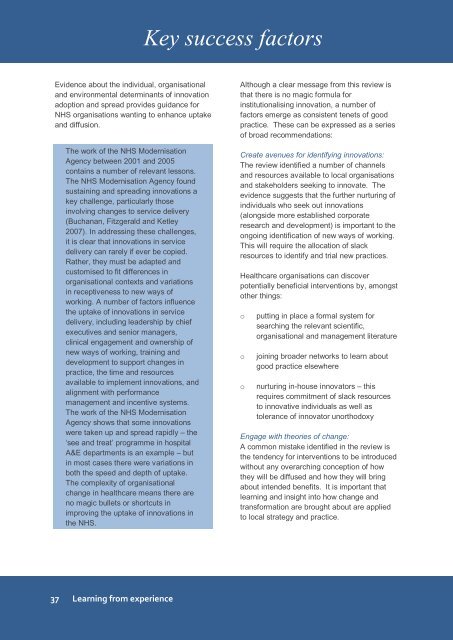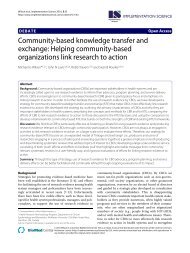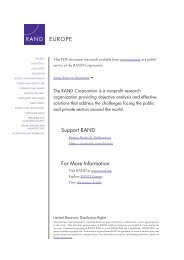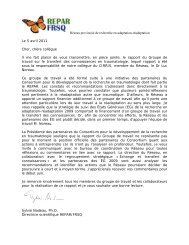Promoting and Embedding Innovation
Promoting and Embedding Innovation
Promoting and Embedding Innovation
You also want an ePaper? Increase the reach of your titles
YUMPU automatically turns print PDFs into web optimized ePapers that Google loves.
Key success factors<br />
Evidence about the individual, organisational<br />
<strong>and</strong> environmental determinants of innovation<br />
adoption <strong>and</strong> spread provides guidance for<br />
NHS organisations wanting to enhance uptake<br />
<strong>and</strong> diffusion.<br />
The work of the NHS Modernisation<br />
Agency between 2001 <strong>and</strong> 2005<br />
contains a number of relevant lessons.<br />
The NHS Modernisation Agency found<br />
sustaining <strong>and</strong> spreading innovations a<br />
key challenge, particularly those<br />
involving changes to service delivery<br />
(Buchanan, Fitzgerald <strong>and</strong> Ketley<br />
2007). In addressing these challenges,<br />
it is clear that innovations in service<br />
delivery can rarely if ever be copied.<br />
Rather, they must be adapted <strong>and</strong><br />
customised to fit differences in<br />
organisational contexts <strong>and</strong> variations<br />
in receptiveness to new ways of<br />
working. A number of factors influence<br />
the uptake of innovations in service<br />
delivery, including leadership by chief<br />
executives <strong>and</strong> senior managers,<br />
clinical engagement <strong>and</strong> ownership of<br />
new ways of working, training <strong>and</strong><br />
development to support changes in<br />
practice, the time <strong>and</strong> resources<br />
available to implement innovations, <strong>and</strong><br />
alignment with performance<br />
management <strong>and</strong> incentive systems.<br />
The work of the NHS Modernisation<br />
Agency shows that some innovations<br />
were taken up <strong>and</strong> spread rapidly – the<br />
„see <strong>and</strong> treat‟ programme in hospital<br />
A&E departments is an example – but<br />
in most cases there were variations in<br />
both the speed <strong>and</strong> depth of uptake.<br />
The complexity of organisational<br />
change in healthcare means there are<br />
no magic bullets or shortcuts in<br />
improving the uptake of innovations in<br />
the NHS.<br />
Although a clear message from this review is<br />
that there is no magic formula for<br />
institutionalising innovation, a number of<br />
factors emerge as consistent tenets of good<br />
practice. These can be expressed as a series<br />
of broad recommendations:<br />
Create avenues for identifying innovations:<br />
The review identified a number of channels<br />
<strong>and</strong> resources available to local organisations<br />
<strong>and</strong> stakeholders seeking to innovate. The<br />
evidence suggests that the further nurturing of<br />
individuals who seek out innovations<br />
(alongside more established corporate<br />
research <strong>and</strong> development) is important to the<br />
ongoing identification of new ways of working.<br />
This will require the allocation of slack<br />
resources to identify <strong>and</strong> trial new practices.<br />
Healthcare organisations can discover<br />
potentially beneficial interventions by, amongst<br />
other things:<br />
o<br />
o<br />
o<br />
putting in place a formal system for<br />
searching the relevant scientific,<br />
organisational <strong>and</strong> management literature<br />
joining broader networks to learn about<br />
good practice elsewhere<br />
nurturing in-house innovators – this<br />
requires commitment of slack resources<br />
to innovative individuals as well as<br />
tolerance of innovator unorthodoxy<br />
Engage with theories of change:<br />
A common mistake identified in the review is<br />
the tendency for interventions to be introduced<br />
without any overarching conception of how<br />
they will be diffused <strong>and</strong> how they will bring<br />
about intended benefits. It is important that<br />
learning <strong>and</strong> insight into how change <strong>and</strong><br />
transformation are brought about are applied<br />
to local strategy <strong>and</strong> practice.<br />
37 Learning from experience
















